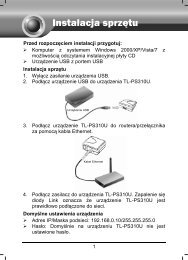TL-WR542G 54M Wireless Router - TP-Link
TL-WR542G 54M Wireless Router - TP-Link
TL-WR542G 54M Wireless Router - TP-Link
Create successful ePaper yourself
Turn your PDF publications into a flip-book with our unique Google optimized e-Paper software.
4.13.8 Remote Management<br />
You can configure the Remote Management function on this page shown in Figure 4-62. This<br />
feature allows you to manage your <strong>Router</strong> from a remote location, via the Internet.<br />
Figure 4-62 Remote Management<br />
‣ Web Management Port - Web browser access normally uses the standard HT<strong>TP</strong> service<br />
port 80. This router’s default remote management Web port number is 80. For greater<br />
security, you can change the remote management Web interface to a custom port by<br />
entering that number in this box provided. Choose a number between 1024 and 65534, but<br />
do not use the number of any common service port.<br />
‣ Remote Management IP Address - This is the current address you will use when<br />
accessing your router from the Internet. The default IP Address is 0.0.0.0. It means this<br />
function is disabled. To enable this function, change the default IP Address to another IP<br />
Address as desired.<br />
To access the router, you will type your router's WAN IP Address into your browser's Address<br />
(in IE) or Location (in Navigator) box, followed by a colon and the custom port number. For<br />
example, if your <strong>Router</strong>'s WAN address is 202.96.12.8 and you use port number 8080, enter in<br />
your browser: http://202.96.12.8:8080. You will be asked for the router's password. After<br />
successfully entering the password, you will be able to access the router's Web-based utility.<br />
<br />
Note: Be sure to change the router’s default password to a very secure password.<br />
4.13.9 Statistics<br />
The Statistics page (shown in Figure 4-63) displays the network traffic of each PC in LAN,<br />
including total traffic and traffic of the last Packets Statistic interval seconds.<br />
69
















